The streptomycin test kit market is estimated at USD 73.4 million in 2025 and is forecasted to reach USD 167.6 million by 2035, representing a CAGR of 8.6%. The market demonstrates a consistent upward trend throughout the forecast period, with the value increasing to USD 79.7 million in 2026 and USD 86.6 million in 2027. Early-year growth reflects the steady adoption of rapid streptomycin detection kits in pharmaceutical quality control and agricultural testing applications. The initial years show moderate YoY increases of approximately 8.6–8.7%, aligning with the CAGR and indicating a stable expansion trajectory supported by regulatory compliance requirements and rising awareness of antibiotic residue monitoring.The global streptomycin test kit market is valued at USD 73.4 million in 2025 and is slated to reach USD 167.6 million by 2035, recording an absolute increase of USD 94.2 million over the forecast period. This translates into a total growth of 128.3%, with the market forecast to expand at a compound annual growth rate (CAGR) of 8.6% between 2025 and 2035. The overall market size is expected to grow by nearly 2.28X during the same period, supported by increasing demand for food safety testing solutions, growing adoption of rapid antibiotic detection technologies in regulatory compliance, and rising consumer preference for accurate residue testing systems across diverse food manufacturing and safety monitoring applications.
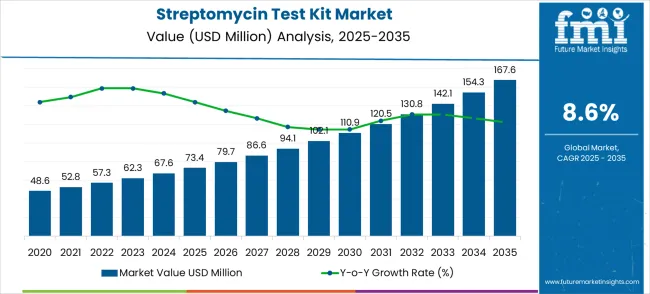
From 2028 to 2031, the market value advances from USD 94.1 million to USD 120.5 million, reflecting a phase of accelerated growth. The annual growth rates during this mid-decade period slightly exceed the average, ranging between 8.9% and 9.1%, highlighting an increased penetration of streptomycin test kits in emerging markets and the introduction of cost-effective, rapid testing technologies. This acceleration indicates the market is gaining momentum due to factors such as heightened safety standards, adoption of precision agriculture practices, and increased demand for food safety testing. The mid-decade contribution accounts for a significant portion of cumulative market growth, focusing the importance of this period in shaping overall market expansion.Between 2025 and 2030, the streptomycin test kit market is projected to expand from USD 73.4 million to USD 113.9 million, resulting in a value increase of USD 40.5 million, which represents 43.0% of the total forecast growth for the decade. This phase of development will be shaped by increasing food safety regulations, rising adoption of rapid testing technologies, and growing demand for antibiotic residue monitoring in food processing and agricultural feed applications. Manufacturers are expanding their streptomycin test kit capabilities to address the growing demand for regulatory compliance and enhanced quality assurance.
| Metric | Value |
|---|---|
| Estimated Value in (2025E) | USD 73.4 million |
| Forecast Value in (2035F) | USD 167.6 million |
| Forecast CAGR (2025 to 2035) | 8.6% |
During the final phase from 2032 to 2035, the market value rises from USD 130.8 million to USD 167.6 million. Annual growth rates during this period moderate slightly to around 8.4–8.5%, reflecting the stabilization of adoption in mature regions. While the growth rate experiences minor deceleration, the market continues to expand steadily due to ongoing regulatory mandates, technological improvements in test kit sensitivity, and wider acceptance in both veterinary and human pharmaceutical testing sectors. These factors mitigate volatility and maintain a predictable growth trajectory.
The market exhibits steady growth with limited volatility. Average YoY growth over the 10-year period remains close to the forecast CAGR of 8.6%, while early adoption, mid-decade acceleration, and late-stage stabilization collectively contribute to the cumulative increase. The market demonstrates a well-balanced expansion, with no years showing unusually high or low growth, indicating strong resilience and predictable performance. Trendline visualization suggests a nearly exponential trajectory, reflecting both market maturity and continued adoption across diverse applications.From 2030 to 2035, the market is forecast to grow from USD 113.9 million to USD 167.6 million, adding another USD 53.7 million, which constitutes 57.0% of the overall ten-year expansion. This period is expected to be characterized by the expansion of 48T/Kit formats and specialized testing configurations, the integration of digital reporting and automated analysis systems, and the development of premium high-sensitivity detection solutions. The growing adoption of comprehensive food safety programs and environmental monitoring initiatives will drive demand for streptomycin test kits with enhanced accuracy features and improved testing efficiency characteristics.
Between 2020 and 2025, the streptomycin test kit market experienced robust growth, driven by increasing demand for food safety testing and growing recognition of streptomycin test kits as essential tools for antibiotic residue detection with superior accuracy and regulatory compliance capabilities. The market developed as food safety professionals and regulatory agencies recognized the potential for streptomycin test kits to improve testing efficiency while ensuring consumer safety and meeting stringent regulatory requirements. Technological advancement in detection methodologies and rapid testing systems began emphasizing the critical importance of maintaining testing accuracy and operational efficiency in advanced food safety monitoring applications.
Market expansion is being supported by the increasing global demand for food safety assurance and the corresponding need for reliable testing solutions that can provide accurate antibiotic residue detection and superior regulatory compliance while maintaining testing efficiency across various food processing and agricultural monitoring applications. Modern food safety professionals are increasingly focused on implementing testing solutions that can detect trace amounts of antibiotics, ensure regulatory compliance, and provide consistent results in demanding quality control environments. Streptomycin test kits' proven ability to deliver superior detection accuracy, enhanced testing reliability, and versatile application compatibility make them essential tools for contemporary food safety and agricultural monitoring solutions.
The growing emphasis focus on consumer health protection and regulatory compliance is driving demand for streptomycin test kits that can support comprehensive residue monitoring, enable rapid detection capabilities, and provide reliable performance in food processing and agricultural applications with minimal false results. Food safety processors' preference for testing systems that combine accuracy with operational efficiency and regulatory acceptance is creating opportunities for innovative streptomycin test kit implementations. The rising influence of sustainable agriculture and food quality trends is also contributing to increased adoption of testing kits that can provide advanced detection solutions without compromising testing reliability or operational convenience.
The market is segmented by classification, application, and region. By classification, the market is divided into 96T/Kit and 48T/Kit. Based on application, the market is categorized into food safety, feed safety, and environmental monitoring. Regionally, the market is divided into North America, Europe, East Asia, South Asia & Pacific, Latin America, and the Middle East & Africa.
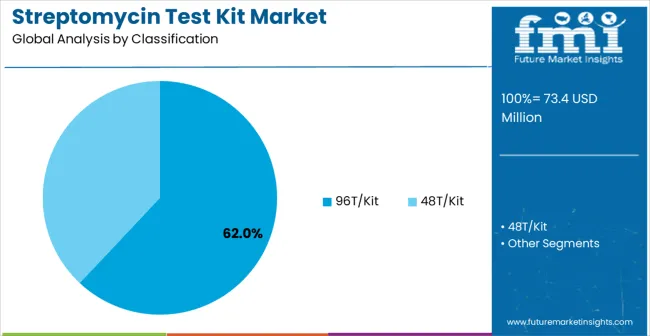
The 96T/Kit segment is projected to account for 62.0% of the streptomycin test kit market in 2025, reaffirming its position as the leading classification category. Food safety laboratories increasingly utilize 96T/Kit formats for their superior testing efficiency, proven cost-effectiveness, and convenience in high-volume testing applications across food processing facilities, regulatory laboratories, and quality control centers. 96T/Kit technology's established throughput capabilities and consistent testing output directly address the laboratory requirements for reliable batch testing and operational efficiency in demanding food safety environments.
This classification segment forms the foundation of modern food safety testing operations, as it represents the kit size with the greatest testing efficiency and established market demand across multiple laboratory categories and testing applications. Laboratory investments in enhanced 96T/Kit testing technologies and automation systems continue to strengthen adoption among food safety professionals. With laboratories prioritizing consistent testing performance and proven cost-effectiveness, 96T/Kit formats align with both efficiency objectives and budget requirements, making them the central component of comprehensive food safety testing strategies.
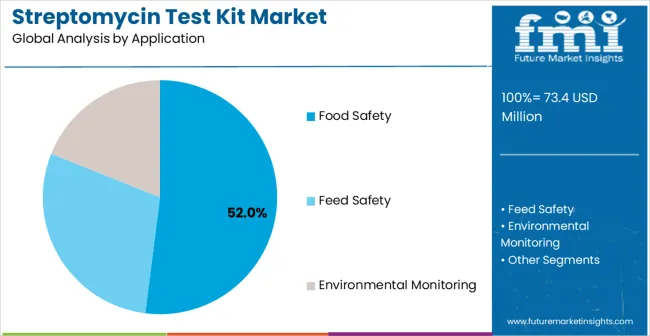
Food safety applications are projected to represent 52.0% of streptomycin test kit demand in 2025, underscoring highlighting their critical role as the primary application market for antibiotic residue detection in food processing and quality control systems. Food safety professionals prefer streptomycin test kits for their exceptional detection accuracy, superior regulatory compliance, and ability to ensure consumer protection while meeting stringent food safety standards and improving quality assurance processes. Positioned as essential tools for modern food safety programs, streptomycin test kits offer both detection advantages and compliance benefits.
The segment is supported by continuous growth in food safety regulations and the growing availability of specialized testing technologies that enable effective residue detection with enhanced accuracy and improved operational efficiency requirements. Additionally , Ffood manufacturers are investing in comprehensive testing systems to support regulatory compliance and consumer protection for demanding food safety standards. As food safety regulations become more stringent and consumer awareness increases, food safety applications will continue to dominate the end-user market while supporting advanced testing utilization and quality assurance strategies.
The streptomycin test kit market is advancing rapidly due to increasing demand for food safety testing and growing adoption of rapid detection technologies that provide enhanced testing accuracy and superior regulatory compliance across diverse food manufacturing and agricultural monitoring applications. However T, the market faces challenges, including technical complexity requirements, cost sensitivity considerations, and the need for specialized laboratory expertise investments. Innovation in automation systems and digital integration continues to influence product development and market expansion patterns.
The growing adoption of 48T/Kit formats and enhanced sensitivity detection methods is enabling testing equipment manufacturers to produce premium streptomycin test kits with superior detection limits, enhanced accuracy characteristics, and advanced testing capabilities. Advanced detection systems provide improved testing reliability while allowing more efficient analysis and consistent output across various sample types and testing conditions. Manufacturers are increasingly recognizing the competitive advantages of advanced detection capabilities for product differentiation and premium market positioning in demanding food safety segments.
Modern streptomycin test kit producers are incorporating digital reporting technologies and automated analysis systems to enhance testing efficiency, improve data management, and ensure consistent performance delivery to food safety professionals and regulatory laboratories. These technologies improve testing reliability while enabling new applications, including real-time monitoring and automated compliance reporting. Advanced digital integration also allows manufacturers to support premium positioning and operational excellence beyond traditional testing kit capabilities.
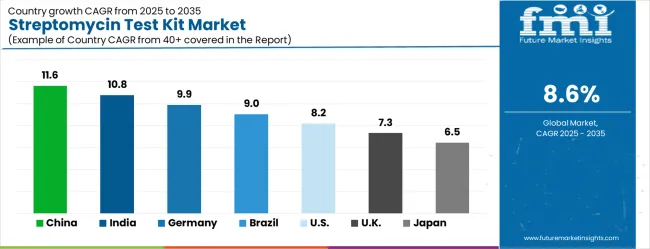
| Country | CAGR (2025-2035) |
|---|---|
| China | 11.6% |
| India | 10.8% |
| Germany | 9.9% |
| Brazil | 9.0% |
| USA | 8.2% |
| UK | 7.3% |
| Japan | 6.5% |
The global market is anticipated to grow at a CAGR of 8.6% between 2025 and 2035, driven by increasing demand for antibiotic residue testing in food and pharmaceutical industries. China leads with 11.6% growth, supported by strict regulatory standards, expanding food safety testing infrastructure, and adoption of advanced diagnostic kits. India follows at 10.8%, reflecting growing awareness of antibiotic residues, rising food safety initiatives, and expanding laboratory capabilities. Germany records 9.9%, driven by high-quality testing standards and advanced analytical technologies. Brazil is projected at 9.0%, supported by increasing food safety regulations and monitoring programs. The United States grows at 8.2% with steady demand in pharmaceutical and food testing, while the United Kingdom expands at 7.3% and Japan at 6.5%, reflecting consistent adoption and regulatory compliance in mature markets.The streptomycin test kit market is experiencing strong growth globally, with China leading at an 11.6% CAGR through 2035, driven by the expanding food safety industry, growing regulatory requirements, and significant investment in food testing infrastructure development. India follows at 10.8%, supported by large-scale food manufacturing expansion, emerging food safety facilities, and growing domestic demand for testing technologies and quality assurance systems. Germany shows growth at 9.9%, emphasizing technological innovation and premium testing equipment development. Brazil records 9.0%, focusing on agricultural monitoring expansion and food safety modernization. The USA demonstrates 8.2% growth, prioritizing advanced testing technologies and high-performance detection solutions. The UK exhibits 7.3% growth, emphasizing food safety capabilities and quality testing adoption. Japan shows 6.5% growth, supported by precision testing manufacturing excellence and advanced detection technology innovation.
The report covers an in-depth analysis of 40+ countries; seven top-performing countries are highlighted below.
China is projected to grow at a CAGR of 11.6% from 2025 to 2035, driven by rising demand in the dairy, livestock, and pharmaceutical industries. Streptomycin test kits are increasingly adopted to ensure antibiotic residue compliance in meat and milk products. Domestic manufacturers are focusing on rapid detection technologies, high-sensitivity reagents, and user-friendly testing kits for both laboratory and field applications. Government regulations enforcing food safety standards and monitoring of antibiotic residues are accelerating market adoption. Growth is further supported by increasing exports of dairy and poultry products that require rigorous testing. Collaborations with international diagnostic firms are enabling technology transfer and enhancing kit accuracy, making China a leading hub for Streptomycin test kit production and usage in Asia.
India is expected to grow at a CAGR of 10.8% during 2025–2035, supported by expanding dairy, poultry, and pharmaceutical testing sectors. Streptomycin test kits are widely adopted for regulatory compliance, food safety, and quality assurance in both domestic and export markets. Indian manufacturers are investing in rapid assay development, high-precision reagents, and portable testing solutions for field and laboratory use. Government initiatives promoting food safety monitoring, residue detection, and agricultural compliance reinforce market growth. Increased awareness among dairy and livestock producers, as well as rising exports of milk and poultry products, further strengthens adoption. Collaborations with global diagnostic firms enhance accuracy, reliability, and market reach of Streptomycin test kits across India.
Germany is projected to grow at a CAGR of 9.9% from 2025 to 2035, driven by stringent EU regulations for food safety and antibiotic residue testing. Streptomycin test kits are widely used in dairy, meat, and pharmaceutical quality control laboratories. German manufacturers focus on high-precision detection technologies, robust reagents, and automated testing systems for efficient residue analysis. Compliance requirements for both domestic consumption and European Union exports further stimulate adoption. Increasing awareness of food safety standards and the demand for organic and residue-free products also drive the market. Collaborations with research institutions and global diagnostics firms enhance technology transfer and product innovation, ensuring high accuracy and reliability of test kits.
Brazil is expected to grow at a CAGR of 9.0% from 2025 to 2035, supported by increasing adoption in dairy, meat, and pharmaceutical industries. Streptomycin test kits are essential for monitoring antibiotic residues and ensuring compliance with local and international food safety regulations. Local manufacturers focus on cost-effective test kits, while imports from Europe and Asia supplement high-precision laboratory applications. Growth is reinforced by increasing meat and dairy exports, government monitoring programs, and rising consumer awareness regarding antibiotic residues. Collaborations with international diagnostic companies enhance technology adoption, accuracy, and kit efficiency across multiple testing environments.
The United States is projected to grow at a CAGR of 8.2% between 2025 and 2035, driven by strong regulatory compliance requirements for dairy, meat, and pharmaceutical products. Streptomycin test kits are widely used in quality assurance laboratories, field testing, and regulatory inspections. Manufacturers focus on rapid detection, high sensitivity reagents, and automation to meet demand. Expansion of livestock, dairy, and pharmaceutical production supports adoption. Increasing awareness of food safety, antibiotic monitoring, and export compliance also contributes to market growth. Collaborations with international diagnostics firms ensure adoption of advanced testing technologies and efficient kit production across both industrial and laboratory applications.
The United Kingdom is expected to grow at a CAGR of 7.3% during 2025–2035, with adoption driven by dairy, poultry, meat, and pharmaceutical industries. Streptomycin test kits are widely used for food safety compliance, residue monitoring, and quality assurance. UK manufacturers focus on high-accuracy detection, user-friendly kits, and portable solutions for field use. Growth is reinforced by increasing government food safety programs, rising exports, and stringent EU regulations. Collaboration with international diagnostic firms ensures access to high-quality reagents and advanced detection technologies. Adoption in laboratories, farms, and export facilities further supports market growth across multiple end-use sectors.
Japan is projected to grow at a CAGR of 6.5% from 2025 to 2035, influenced by adoption in livestock, dairy, pharmaceutical, and food processing sectors. Streptomycin test kits are essential for monitoring antibiotic residues to comply with domestic and export standards. Japanese manufacturers emphasize rapid assay development, high sensitivity reagents, and automation for laboratory and field testing. Government regulations and food safety initiatives are driving adoption. Growing exports of meat, dairy, and pharmaceutical products also reinforce demand. Collaborations with international diagnostic firms improve kit reliability, accuracy, and efficiency, supporting the growing requirement for residue-free food and quality assurance in Japanese industries.
Revenue from streptomycin test kits in China is projected to exhibit exceptional growth with a CAGR of 11.6% through 2035, driven by expanding food safety infrastructure development and rapidly growing regulatory compliance requirements supported by government food quality initiatives. The country's abundant food manufacturing capacity and increasing investment in testing technology are creating substantial demand for antibiotic residue detection solutions. Major food companies and testing equipment manufacturers are establishing comprehensive test kit capabilities to serve both domestic and international markets.
Government support for food safety development and testing technology expansion is driving demand for streptomycin test kit technologies throughout major food production regions and testing centers. Strong food manufacturing sector growth and an expanding network of quality control facilities are supporting the rapid adoption of testing systems among manufacturers seeking enhanced food safety performance and regulatory compliance.
Revenue from streptomycin test kits in India is expanding at a CAGR of 10.8%, supported by the country's growing food manufacturing capacity, emerging food safety facilities, and increasing domestic demand for advanced testing technologies and quality control solutions. The country's developing food supply chain and growing agricultural industry are driving demand for sophisticated testing capabilities. International testing technology providers and domestic manufacturers are establishing extensive production and distribution capabilities to address the growing demand for streptomycin test kit products.
Rising food manufacturing industry development and expanding quality control deployment patterns are creating opportunities for test kit adoption across food processors, agricultural companies, and testing laboratory facilities in major food production areas. Growing government focus on food safety modernization and consumer protection is driving adoption of advanced testing technologies among food enterprises seeking enhanced quality assurance and market competitiveness.
Revenue from streptomycin test kits in Germany is expanding at a CAGR of 9.9%, supported by the country's advanced food safety industry, strong emphasis on technological innovation, and robust demand for high-performance testing solutions among quality-focused laboratories. The nation's mature food manufacturing sector and high adoption of precision testing technologies are driving sophisticated detection capabilities throughout the food chain. Leading manufacturers and technology providers are investing extensively in premium testing equipment development and advanced detection methods to serve both domestic and export markets.
Rising laboratory preference for high-accuracy testing and advanced detection performance is creating demand for sophisticated streptomycin test kit systems among food safety facilities seeking enhanced testing reliability and regulatory optimization. Strong technological expertise and growing emphasis on food safety excellence are supporting adoption of premium testing solutions across food manufacturing and precision testing applications in major industrial centers.
Revenue from streptomycin test kits in Brazil is growing at a CAGR of 9.0%, driven by expanding agricultural monitoring infrastructure, increasing food safety facility modernization patterns, and growing investment in testing technology development. The country's developing agricultural resources and modernization of food processing facilities are supporting demand for advanced testing technologies across major production regions. Food companies and agricultural operators are establishing comprehensive capabilities to serve both domestic food centers and emerging export markets.
Government initiatives promoting food safety development and agricultural quality monitoring are driving adoption of modern testing systems including streptomycin test kits and advanced detection methods. Rising demand for food quality assurance in agricultural areas is supporting market expansion, while robust food manufacturing sector growth provides opportunities for testing equipment adoption throughout the country's food production facilities.
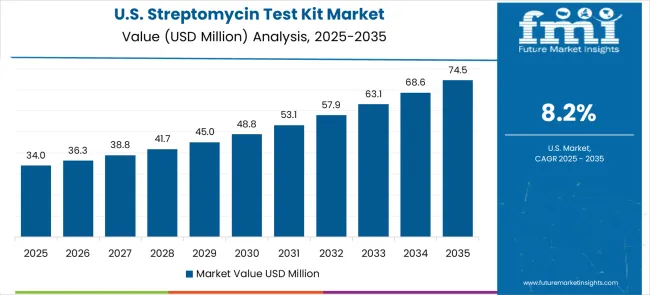
Revenue from streptomycin test kits in the USA is expanding at a CAGR of 8.2%, supported by the country's advanced food safety industry, emphasis on high-performance testing supply, and strong demand for sophisticated detection solutions among quality-focused laboratories. The USA's established testing technology sector and regulatory expertise are supporting investment in advanced detection capabilities throughout major testing centers. Industry leaders are establishing comprehensive quality management systems to serve both domestic and export markets with premium testing solutions.
Innovations in testing technologies including enhanced detection systems and advanced analysis methods are creating demand for superior testing performance and advanced food safety capability among quality-focused manufacturers. Growing technological advancement and rising demand for high-performance food safety testing are driving adoption of sophisticated streptomycin test kits across food manufacturing and testing laboratory applications throughout the country.
Revenue from streptomycin test kits in the UK is growing at a CAGR of 7.3%, driven by the country's food safety industry, emphasis on quality testing adoption, and strong demand for high-performance detection solutions among established laboratories. The UK's mature food sector and focus on testing excellence are supporting investment in advanced detection capabilities throughout major testing centers. Food safety companies are establishing comprehensive testing systems to serve both domestic and international markets with quality detection solutions.
Advanced food safety expertise and established testing capabilities are creating opportunities for premium testing adoption and enhanced food safety performance among quality-focused laboratories throughout major food regions. Growing emphasis on food safety innovation and regulatory advancement is driving adoption of streptomycin test kit systems across food manufacturing and precision testing applications throughout the country.
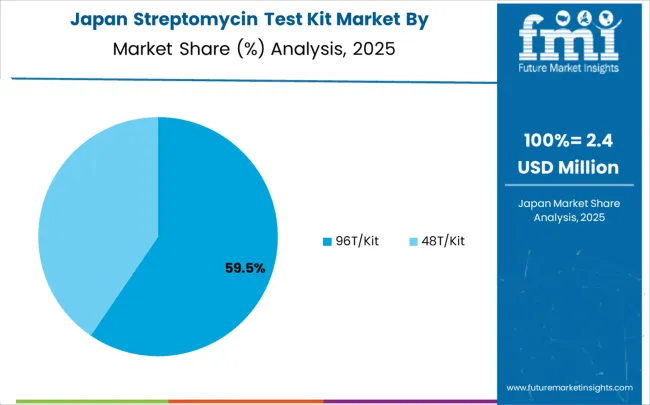
Revenue from streptomycin test kits in Japan is expanding at a CAGR of 6.5%, supported by the country's focus on precision manufacturing excellence, advanced testing applications, and strong preference for high-quality detection solutions. Japan's sophisticated food safety industry and emphasis on testing precision are driving demand for advanced testing technologies including premium detection kits and high-performance analysis methods. Leading manufacturers are investing in specialized capabilities to serve testing equipment production, food safety operations, and precision detection applications with premium testing offerings.
Regional specialization in precision manufacturing and advanced technology development is creating opportunities for premium testing positioning and distinctive product development throughout major manufacturing regions. Strong emphasis on food safety quality combined with advanced detection requirements is driving adoption of testing technologies that deliver exceptional accuracy while meeting contemporary food safety excellence needs.
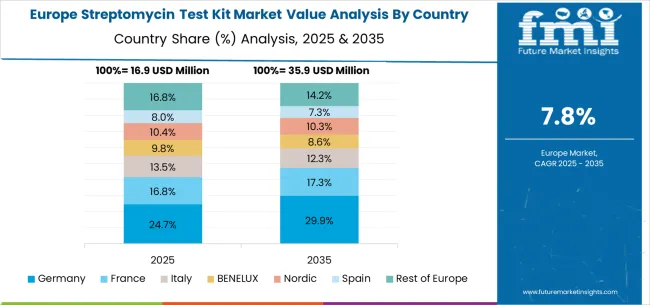
The streptomycin test kit market in Europe is projected to grow from USD 16.2 million in 2025 to USD 36.9 million by 2035, registering a CAGR of 8.6% over the forecast period. Germany is expected to maintain its leadership position with a 25.0% market share in 2025, declining slightly to 24.5% by 2035, supported by its strong food safety industry, advanced testing facilities, and comprehensive quality control supply network serving major European markets.
France follows with an 18.5% share in 2025, projected to reach 18.8% by 2035, driven by robust demand for streptomycin test kits in food manufacturing, agricultural monitoring, and testing laboratory applications, combined with established food safety traditions incorporating advanced testing technologies. The United Kingdom holds a 16.0% share in 2025, expected to decrease to 15.7% by 2035, supported by strong food safety sector demand but facing challenges from competitive pressures and regulatory restructuring. Italy commands a 14.0% share in 2025, projected to reach 14.2% by 2035, while Spain accounts for 12.5% in 2025, expected to reach 12.8% by 2035. The Netherlands maintains a 4.5% share in 2025, growing to 4.7% by 2035. The Rest of Europe region, including Nordic countries, Eastern Europe, Portugal, Belgium, Switzerland, and Austria, is anticipated to gain momentum, expanding its collective share from 9.5% to 9.3% by 2035, attributed to increasing adoption of food safety testing technologies in Nordic countries and growing testing activities across Eastern European markets implementing food safety modernization programs.
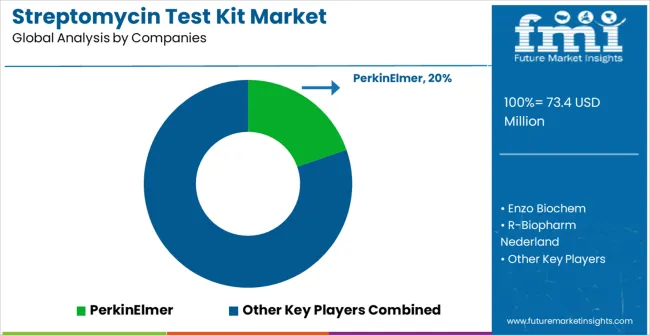
The market is highly competitive, driven by accuracy, sensitivity, and rapid detection capabilities for food safety and pharmaceutical applications. PerkinElmer, Danaher, and Enzo Biochem lead with validated kits that ensure reliable streptomycin detection in milk, meat, and other consumables. Their competitive edge stems from global distribution networks, extensive technical support, and rigorous quality control. Product brochures highlight detection limits, assay speed, and reproducibility, appealing to laboratories, regulatory agencies, and large-scale food producers seeking dependable testing solutions.
R-Biopharm Nederland and Charm Sciences compete by offering specialized, cost-effective kits for small and mid-sized laboratories. Their products emphasize ease of use, minimal sample preparation, and compliance with international testing standards. J&G Biotech, Shandong Meizheng Bio-Technology, and Shanghai Jianglai Industrial differentiate through localized production, faster turnaround times, and tailored solutions for regional food safety monitoring programs. These firms target emerging markets with competitive pricing while maintaining adequate sensitivity and reliability.
Shenzhen Reagent Technology and other smaller regional players focus on niche applications and customized solutions. Product brochures highlight low detection thresholds, kit shelf life, and compatibility with multiple sample types. Competition in this market is defined by accuracy, speed, regulatory compliance, and technical support. Leading manufacturers invest in assay optimization, high-throughput capabilities, and workflow integration, while regional suppliers leverage affordability and responsive customer service. Continuous focus on improving detection sensitivity and user convenience shapes the competitive dynamics in the streptomycin test kit market.The streptomycin test kit market is characterized by competition among established biotechnology companies, specialized testing equipment suppliers, and integrated food safety solution providers. Companies are investing in advanced detection technology research, assay optimization, automated testing development, and comprehensive product portfolios to deliver consistent, high-quality, and cost-effective streptomycin test kit solutions. Innovation in detection methodologies, testing automation, and regulatory compliance systems is central to strengthening market position and competitive advantage.
PerkinElmer leads the market with a strong market share, offering comprehensive analytical solutions with a focus on food safety applications and advanced detection systems. Enzo Biochem provides specialized biotechnology capabilities with an emphasis on testing technologies and analytical excellence. R-Biopharm Nederland delivers innovative food safety solutions with a focus on European markets and product versatility. Charm Sciences specializes in food safety testing and advanced detection solutions for regulatory markets. Danaher focuses on analytical instrumentation and integrated testing operations. J&G Biotech offers specialized testing products with emphasis on Asian markets and biotechnology applications.
| Items | Values |
|---|---|
| Quantitative Units (2025) | USD 73.4 Million |
| Classification | 96T/Kit, 48T/Kit |
| Application | Food Safety, Feed Safety, Environmental Monitoring |
| Regions Covered | North America, Europe, East Asia, South Asia & Pacific, Latin America, Middle East & Africa |
| Countries Covered | United States, Canada, United Kingdom, Germany, France, China, Japan, South Korea, India, Brazil, Australia and 40+ countries |
| Key Companies Profiled | PerkinElmer, Enzo Biochem, R-Biopharm Nederland, Charm Sciences, Danaher, and J&G Biotech |
| Additional Attributes | Dollar sales by classification and application category, regional demand trends, competitive landscape, technological advancements in detection systems, assay innovation, automation development, and testing optimization |
North America
Europe
East Asia
South Asia & Pacific
Latin America
Middle East & Africa
The global streptomycin test kit market is estimated to be valued at USD 73.4 million in 2025.
The market size for the streptomycin test kit market is projected to reach USD 167.6 million by 2035.
The streptomycin test kit market is expected to grow at a 8.6% CAGR between 2025 and 2035.
The key product types in streptomycin test kit market are 96t/kit and 48t/kit.
In terms of application, food safety segment to command 52.0% share in the streptomycin test kit market in 2025.






Our Research Products

The "Full Research Suite" delivers actionable market intel, deep dives on markets or technologies, so clients act faster, cut risk, and unlock growth.

The Leaderboard benchmarks and ranks top vendors, classifying them as Established Leaders, Leading Challengers, or Disruptors & Challengers.

Locates where complements amplify value and substitutes erode it, forecasting net impact by horizon

We deliver granular, decision-grade intel: market sizing, 5-year forecasts, pricing, adoption, usage, revenue, and operational KPIs—plus competitor tracking, regulation, and value chains—across 60 countries broadly.

Spot the shifts before they hit your P&L. We track inflection points, adoption curves, pricing moves, and ecosystem plays to show where demand is heading, why it is changing, and what to do next across high-growth markets and disruptive tech

Real-time reads of user behavior. We track shifting priorities, perceptions of today’s and next-gen services, and provider experience, then pace how fast tech moves from trial to adoption, blending buyer, consumer, and channel inputs with social signals (#WhySwitch, #UX).

Partner with our analyst team to build a custom report designed around your business priorities. From analysing market trends to assessing competitors or crafting bespoke datasets, we tailor insights to your needs.
Supplier Intelligence
Discovery & Profiling
Capacity & Footprint
Performance & Risk
Compliance & Governance
Commercial Readiness
Who Supplies Whom
Scorecards & Shortlists
Playbooks & Docs
Category Intelligence
Definition & Scope
Demand & Use Cases
Cost Drivers
Market Structure
Supply Chain Map
Trade & Policy
Operating Norms
Deliverables
Buyer Intelligence
Account Basics
Spend & Scope
Procurement Model
Vendor Requirements
Terms & Policies
Entry Strategy
Pain Points & Triggers
Outputs
Pricing Analysis
Benchmarks
Trends
Should-Cost
Indexation
Landed Cost
Commercial Terms
Deliverables
Brand Analysis
Positioning & Value Prop
Share & Presence
Customer Evidence
Go-to-Market
Digital & Reputation
Compliance & Trust
KPIs & Gaps
Outputs
Full Research Suite comprises of:
Market outlook & trends analysis
Interviews & case studies
Strategic recommendations
Vendor profiles & capabilities analysis
5-year forecasts
8 regions and 60+ country-level data splits
Market segment data splits
12 months of continuous data updates
DELIVERED AS:
PDF EXCEL ONLINE
Soil Testing Kit Market Growth - Trends & Forecast 2025 to 2035
Water Testing Kit Market Analysis by Product, Test Type, Water Type, End User, and Region - Analysis for 2025 to 2035
Fungal Testing Kits Market Analysis – Size, Trends & Forecast 2025 to 2035
Ovulation Test Kit Market Analysis – Growth & Industry Trends 2024-2034
Cortisol Testing Kits Market Size and Share Forecast Outlook 2025 to 2035
Oxytocin Testing Kits Market Analysis - Size, Share, and Forecast Outlook 2025 to 2035
Global Bowie-Dick Test Kit Market Analysis – Size, Share & Forecast 2024-2034
Rapid RNA Testing Kits Market Trends- Growth & Forecast 2025 to 2035
HIV/HBV/HCV Test Kits Market Trends and Forecast 2025 to 2035
Irrigation testing kit Market
Nucleic Acid Test Kits for Pets Market Size and Share Forecast Outlook 2025 to 2035
Lab Screening Test Kit Market
Chloramphenicol Test Kits Market Size and Share Forecast Outlook 2025 to 2035
Total Aflatoxin Test Kit Market Size and Share Forecast Outlook 2025 to 2035
Fluoroquinolone Test Kit Market Size and Share Forecast Outlook 2025 to 2035
Self-sampling HPV Test Kits Market Analysis - Size, Share, and Forecast Outlook 2025 to 2035
Demand for Water Testing Kit in Japan Size and Share Forecast Outlook 2025 to 2035
Lab Confirmation Testing Kit Market
At-Home Vaginal pH Test Kit Market Size and Share Forecast Outlook 2025 to 2035
Veterinary Pregnancy Test Kit Market Forecast and Outlook 2025 to 2035

Thank you!
You will receive an email from our Business Development Manager. Please be sure to check your SPAM/JUNK folder too.
Chat With
MaRIA